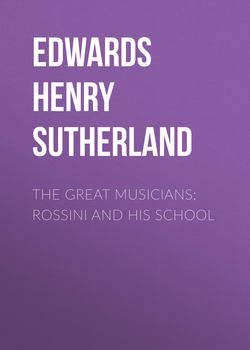The Great Musicians: Rossini and His School

Реклама. ООО «ЛитРес», ИНН: 7719571260.
Оглавление
Edwards Henry Sutherland. The Great Musicians: Rossini and His School
CHAPTER I. ROSSINI'S CHILDHOOD AND YOUTH
CHAPTER II. LA PIETRA DEL PARAGONE
CHAPTER III. ITALIAN OPERA UNTIL THE TIME OF ROSSINI
CHAPTER IV. TANCREDI
CHAPTER V. OPERATIC CUSTOMS IN ROSSINI'S TIME
CHAPTER VI. ROSSINI AT NAPLES
CHAPTER VII. PREPARATIONS FOR THE BARBER
CHAPTER VIII. IL BARBIERE
CHAPTER IX. ROSSINI AND THE COMIC IN MUSIC
CHAPTER X. FROM "OTELLO" TO "SEMIRAMIDE."
CHAPTER XI. ROSSINI ON HIS TRAVELS
CHAPTER XII. DONIZETTI AND BELLINI
CHAPTER XIII. VERDI
LIST OF ROSSINI'S WORKS WITH THE DATE OF THEIR PRODUCTION IN PUBLIC
Отрывок из книги
ROSSINI had already written two operas in 1812, and he was destined in this fertile year to produce three more: two at Venice, La Scala di Seta and L'Occasione fa il Ladro; and one at Milan, La Pietra del Paragone.
La Pietra del Paragone was Rossini's next great success after L'Inganno Felice. The leading parts were assigned to Galli, afterwards one of the most famous bass-singers of his time, and to Madame Marcolini, who had played the principal character in L'Equivoco Stravagante, and who had particularly distinguished herself in that work by her singing of the final rondo before mentioned.
.....
"I must beg of you then to remove from your bills the word new, together with my name as author, and to substitute instead the following: – 'Opera, consisting of pieces by M. Rossini, arranged by M. Berettoni.'
"I request that this alteration may appear in the bills of to-morrow, in default of which I shall be obliged to ask from justice what I now ask from your good faith.
.....